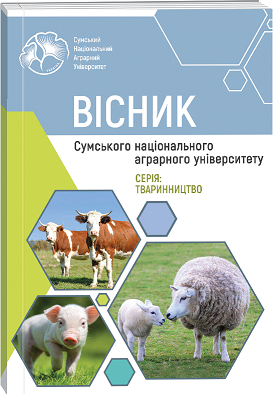MILK PRODUCTIVITY OF COWS UNDER THE EFFECT OF NANOCARBOXYLATES OF MICRO ELEMENTS
Abstract
The article presents the results of the influence of trace elements in the form of nanocarboxylates and the drug Quatronan-Se on the indicators of milk productivity of cows of the Ukrainian black-spotted dairy breed. Studies were also carried out to determine the concentration of the studied microelements in the milk of experimental animals. 4 groups were formed to conduct the research. The animals were injected with drugs on the 10th, 11th and 12th day of the sexual cycle, the experimental one – Cu, Se, Mn, Cr, II – Quatronane-Se, III – Cu, Ge, Mn, Cr and the control physiological solution. 5 milk samples were taken from the 9th to the 13th day of the sexsual cycle. According to the results of the study, it was established that the level of each trace element on the 9th day was lower compared to the 13th day, but was within physiological limits. The biggest changes were observed in the content of Cr, on the 13th day its level was 0.0655 mg/l, which is 24.4% higher compared to the 9th day. A comparative analysis of the control and experimental groups shows that the concentration of Ge, Se and Mn on the 13th day in the experimental group was 9%, 2.7% and 9% higher compared to the control. Indicators of average daily hope indicate that the drugs with threefold administration do not have a negative effect on hope, since in all groups on the 13th day there is an increase in average daily hope by 12.9%, 4.4%, 2.8%, 8.9% in the control group, and II and III research group, respectively. The comparative analysis of the indicators of fat content in milk shows that in the control and the 1st experimental group, the difference between the 9th and 13th day was 1%. The analysis of the protein content showed that there were no significant changes in the dynamics of this indicator in all groups. It should also be noted that the highest rate of fertilization was in the II experimental group, which is 40% higher compared to the control and 20% higher than the I and III experimental groups.
References
2. Hruntkovskyi, M. S., Sheremeta, V. I. & Kaplunenko, V. H. (2015) Vidtvoriuvalna zdatnist koriv za vykorystannia preparatu Nanovulin –VRKh [Eproductive ability of cows using drug Nanovulin-VHR]. Rozvedennia i henetyka tvaryn, 49, 199-203. (in Ukrainian)
3. Doletskyi, S. P. (2012). Mineralne zhyvlennia tvaryn ta umist mikroelementiv i vazhkykh metaliv u kormakh riznykh rehioniv Ukrainy za suchasnykh ekolohichnykh umov [Mineral nutrition of animals and the content of trace elements and heavy metals in fodder of different regions of Ukraine under modern ecological conditions]. Naukovyi visnyk Natsionalnoho universytetu bioresursiv i pryrodokorystuvannia Ukrainy, 172 (4), 94-99. (in Ukrainian)
4. Kalynovskyi, H. M., Revunets, A. S. & Hryshchuk, H. P. (2009). Hormonalnyi ta mikroelementnyi sklad tkanynnoho preparatu fetoplatsentatu, vyhotovlenoho z matky riznykh vydiv tvaryn [Hormonal and microelemental composition of the tissue preparation of fetoplacenta, made from the uterus of various animal species]. Naukovyi visnyk NUBiP, 136, 76-81. (in Ukrainian)
5. Lytvynenko, D. Yu. (2012). Nanotekhnolohii u veterynarnii medytsyni [Nanotechnology in veterinary medicine]. Naukovyi visnyk Natsionalnoho universytetu bioresursiv i pryrodokorystuvannia Ukrainy, 172 (1) 228-231. (in Ukrainian)
6. Pelekhatyi, M. S. ta in. (1999). Vidtvoriuvalna zdatnist chorno-riabykh koriv riznoho pokhodzhennia i henotypiv v umovakh ukrainskoho Polissia [Reproductive capacity of black-spotted cows of different origins and genotypes in the conditions of Ukrainian Polissia]. Rozvedennia i henetyka tvaryn. Ahrarna nauka, 31-32, 180–182. (in Ukrainian)
7. Sakhanda, I. V., Polova, Zh. M. (2014). Aktualnist farmatsevtychnoi rozrobky preparativ midi [Relevance of pharmaceutical development of copper preparations]. Ukrainskyi naukovo-medychnyi molodizhnyi zhurnal, 3, 138-140. (in Ukrainian)
8. Fedoruk, R., Khomyn, M. & Kropyvka, S. (2014). Vykorystannia nanokarboksylativ: korovy – produktyvnishi, moloko – pozhyvnishe [Use of nanocarboxylates: cows are more productive, milk is more nutritious]. Tvarynnytstvo Ukrainy, 6, 26-30. (in Ukrainian)
9. Shatorna, V. F., Harets, V. I., Savenkova, O.O. & Kolosova I. I. (2013). Doslidzhennia vplyvu nanometaliv na stan reproduktyvnoi funktsii v eksperymenti [Study of the influence of nanometals on the state of reproductive function in an experiment]. Tavrycheskyi medyko-byolohycheskyi vestnyk, 16(1), 246-250. (in Ukrainian) 10. Shkurko, T. (2004). Vidtvorna zdatnist importnoi holshtynskoi porody v period aklimatyzatsii. [Reproductive capacity of the imported Holstein breed during the acclimatization period] Tvarynnytstvo Ukrainy, 9, 18–21. (in Ukrainian)
11. Ianovych, V. H. & Solohub, L. I. (2000) Biolohchni osnovy transformatsii pozhyvnykh rechovyn u zhuinykh tvaryn [Reproductive capacity of the imported Holstein breed during the acclimatization period]. Lviv: „Triada plius”, 384. (in Ukrainian)
12. Bykadorov, P.P. (2015). Relationship Аnalysis of milk production and reproductive ability of black and white cattle in the conditions of Donbass. Russian Journal of Agricultural and Socio-Economic Sciences, 12 (48) 49-52.
13. Dobson, H., Smith, R.F., Royal, M.D. Knight, C.H. & Sheldon, I. M. (2007). The high producing dairy cow and its reproductive performance. Reprod Domest Anim., 42(2), 17-23.
14. Hostetler, C. et al. (2003). The role of essential trace elements in embryonic and fetal development in livestock. The Veterinary Journal, 2, 125–139.
15. Kala, R., Samková E., Pecová, L., Hanuš, O., Sekmokas, K. & Riaukienė, D. (2018). An Overview of Determination of Milk Fat: Development, Quality Control Measures, and Application. Acta Universitatis Agriculturae et Silviculturae Mendelianae Brunensis, 66(4), 1055-1064.
16. Scott, N. R. (2005). Nanotechnology and animal health. Rev. Sci. Tech. Off. Int. Epiz, 24 (1), 425-432.
17. Shkirin, A.V., Ignatenko, D. N., Chirikov, S. N., Bunkin, N. F. & Gudkov, S.V. (2021). Analysis of Fat and Protein Content in Milk Using Laser Polarimetric Scatterometry. Agriculture, 11, 1028-1038.

 ISSN
ISSN  ISSN
ISSN 



